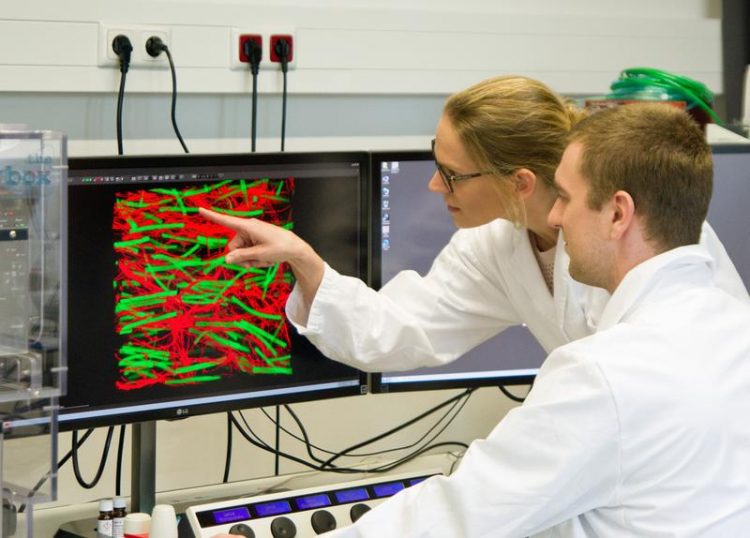An injectable guidance system for nerve cells

Dr.-Ing. Laura De Laporte and PhD student Jonas Rose analyze the orientation of nerve cells (red) along the paths provided by gel rods (green). J. Hillmer, DWI
Inside the body, an extracellular matrix surrounds the cells. It provides mechanical support and promotes spatial tissue organization. In order to regenerate damaged tissue, an artificial matrix can temporally replace the natural extracellular matrix.
This matrix needs to mimic the natural cell environment in order to efficiently stimulate the regenerative potential of the surrounding tissue. Solid implants, however, may impair remaining healthy tissue whereas soft, injectable materials allow for a minimal invasive therapy, which is particularly beneficial for sensitive tissues, such as the spinal cord. Unfortunately, up to now, artificial soft materials did not yet reproduce the complex structures and spatial properties of natural tissues.
A team of scientists, headed by Dr.-Ing. Laura De Laporte from the DWI – Leibniz Institute for Interactive Materials, developed a new, minimal invasive material termed ‚Anisogel‘. “If you aim to enhance the regeneration of damaged spinal cord tissue, you need to come up with a new material concept,” says Jonas Rose. He is a PhD student working on the Anisogel project.
“We use micrometer-sized building blocks and assemble them into 3D hierarchically organized structures.” Anisogel consists of two gel components. Many, microscopically small, soft rod-shaped gels, incorporated with a low amount of magnetic nanoparticles, are the first component. Using a weak magnetic field, scientists can orient the gel rods, after which a very soft surrounding gel matrix is crosslinked, forming the structural guidance system.
The gel rods, being stabilized by the gel matrix, maintain their orientation, even after removal of the magnetic field. Using cell culture experiments, the researchers demonstrate that cells can easily migrate through this gel matrix, and that nerve cells and fibroblasts orient along the paths provided by this guidance system.
A low amount of one percent gel rods inside the entire Anisogel volume is proven to be sufficient to induce linear nerve growth. The material, developed by the Aachen-based scientists, is the first injectable biomaterial, which assembles into a controlled oriented structure after injection and provides a functional guidance system for cells.
„To meet the complex requirements of this approach, the project team includes researchers with very different areas of expertise,“ says Laura De Laporte, whose research is supported by a Starting Grant of the European Research Council. „This interdisciplinary work is what makes this project so fascinating.“
„Although our cell culture experiments were successful, we are prepared to go a long way to translate our Anisogel into a medical therapy. In collaboration with the Uniklinik RWTH Aachen, we currently plan pre-clinical studies to further test and optimize this material.“
With its work on bioactive materials, the DWI – Leibniz Institute for Interactive Materials contributes to the research network ‚Leibniz Health Technologies’. Within this network, 14 institutes of the Leibniz Association work on specific technical solutions for urgent medical problems. The network’s overall motivation is to improve medical treatment of patients. Its interdisciplinary approach aims to coalesce prevention, diagnostics and therapy, thereby increasing the health-related quality of life.
Publication:
Rose, J. C., Cámara-Torres, M., Rahimi, K., Köhler, J., Möller, M., & De Laporte, L. (2017). Nerve Cells Decide to Orient inside an Injectable Hydrogel with Minimal Structural Guidance. Nano Letters.
Media Contact
More Information:
http://www.dwi.rwth-aachen.deAll latest news from the category: Life Sciences and Chemistry
Articles and reports from the Life Sciences and chemistry area deal with applied and basic research into modern biology, chemistry and human medicine.
Valuable information can be found on a range of life sciences fields including bacteriology, biochemistry, bionics, bioinformatics, biophysics, biotechnology, genetics, geobotany, human biology, marine biology, microbiology, molecular biology, cellular biology, zoology, bioinorganic chemistry, microchemistry and environmental chemistry.
Newest articles

Properties of new materials for microchips
… can now be measured well. Reseachers of Delft University of Technology demonstrated measuring performance properties of ultrathin silicon membranes. Making ever smaller and more powerful chips requires new ultrathin…

Floating solar’s potential
… to support sustainable development by addressing climate, water, and energy goals holistically. A new study published this week in Nature Energy raises the potential for floating solar photovoltaics (FPV)…

Skyrmions move at record speeds
… a step towards the computing of the future. An international research team led by scientists from the CNRS1 has discovered that the magnetic nanobubbles2 known as skyrmions can be…





















